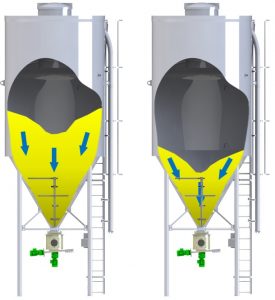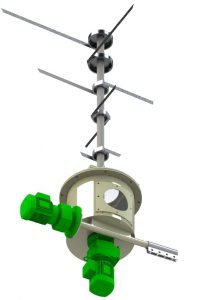Industrial Silos Blockages Issues
Preventing and fixing industrial silos blockages such as tunnels flows, arching, bridging or segregation, with Sodimate’s Mechanical Bin Activator.
Industries handling various chemical products may experience blockages issues in their silos. It’s essential to understand the basic concepts involved in a problematic flow to choose the right discharging equipment.
Silos can clog and hold the powder, but they are necessary when the process uses few supplies and requires high dry consumption. The main issues observed are the creation of blockages such as tunnel flows, arching, bridging or segregation. Our solutions prevent their formation and have the ideal discharge scenario, known as “mass flow”.
What is the ideal function of your silo?
Mounted at the bottom of the silo, a vibrating bin activator acted as a discharge mechanism. It was combined with a rotary airlock as the feeder, running during the entire batching process. This could only provide a consistent feedrate if the density of the material was not affected by the vibrations. In this configuration it was difficult to guarantee an accurate and constant flow of powder. The vanes of the rotary airlock did not coat with material causing the volumetric displacement to differ.
What is happening in the silo that result in flow issues?
Flow issues can create a complete blockage of the powder or a discontinuous discharge under the silo resulting in inaccurate metering and results. A complete understanding of each product and their physical properties is mandatory to list the right equipment. For the powders that do not flow freely, like hydrated lime, Sodimate provides a silo combined with a Mechanical Bin Activator to ensure a continuous discharge. If products are sensitive to moisture, like soda ash, we integrate a dehumidifier connected to the fill line.
Type of issues:
Chimney or Tunnel flow:
Also called rat-holding, most of these issues occur when the flow is happening mainly along the centerline, thus forming a vertical tunnel over the silo’s flange. When the silo is refilled the remaining powder is compressed up against the side, creating unflowable areas named “dead zones”. They often move in an avalanche form with blocks that clog the silo easily. This not only hinders uniform discharging, but it also impacts the storage capacity of the unit.
Bridging or Arching:
Completely stops the flow of the powder. This happens due to static pressure inside the silo cone because the diameter is gradually reduced from 14 feet to 8 inches. When the powder level is above four feet, the bridges and arches are naturally corrected. However, the area below four feet requires the direct operation of Sodimate’s Mechanical Bin Activator. It prevents bridging or arching with a set of flexible rotating blades that unfold inside the powder, from the centerline to the cone wall.
Segregation due to Vibrations:
Happens when the silo experiences excessive vibration. The small and large particles separate from each other and divide the silo into several areas of densities. Some areas become more solidified, leading to a blockage over the flange or an irregular dosage during unloading. For this reason, Sodimate doesn’t provide vibrating systems for silos. Instead, our Mechanical Bin Activator ensures a gentle flow that integrates a transition hopper under the silo, to stabilize the density and constantly feed the volumetric metering screws at 100%.
Blockages in Silos can also result from a combination of these problems.
Guillaume Souchet, Sales Engineer at Sodimate Inc.















